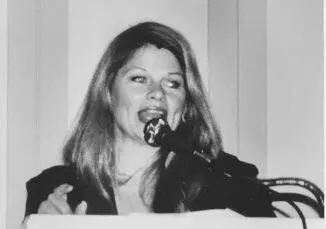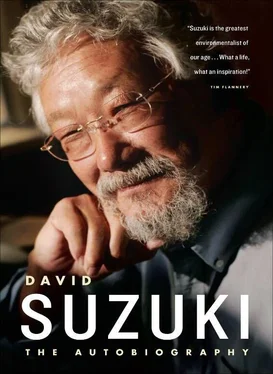As Willard and Nick staged celebrations of the watershed, invited biologists to talk about biodiversity and nutrient flow, organized tree-planting days, and held salmon barbecues to mark the role of fish in our lives, the city and funding agencies found the restoration of Musqueam Creek irresistible. Not only did the duo get funding for the project, the city supported construction of a different kind of roadway in the surrounding area so that water could percolate back into the soil of the watershed instead of being sent down storm sewers to run into the ocean. The team even brought dead salmon from other runs and distributed them along the banks of the creek to return nutrients to the soil, as had happened naturally before “progress” intervened.
Musqueam Creek is on its way back to health; the number of returning fish rose to over fifty in 2004. Nature is incredibly generous when we give her a hand.
TARA WAS NAMED PRESIDENT of the foundation but was not paid for the long, often arduous hours she had put in to get it going. As projects were developed and staff began to pour out material, I was given credit for much of it because the organization carries my name, but in reality — as with the television shows I do — the foundation produces material through the hard work of a devoted team. Volunteers like Tara and me have been a crucial part of the organization's work and effectiveness; I have been amazed at the devotion and hours volunteers give, not just to us, but to so many important causes. They are part of the glue that holds society together.
As the foundation has taken on issues and projects, we also have become increasingly efficient in getting our message across. Our goal was to invest half of every foundation dollar in communication, since public education and awareness are crucial to our mandate of offering solutions. David Hocking, with long experience at Petrocan, came to us to head the communications team.
Having staff behind us also meant Tara and I were no longer feeling isolated or harried. If I was to talk to some special interest group or meet a political leader, the staff would often update background notes that made me so much more effective.
It is clear that the old ways of confrontation, protests, and demonstrations so vital from the 1960s through the '80s, have become less compelling to a public jaded by sensational stories of violence, terror, and sex. We need new alliances and partnerships and ways of informing people.

Tara delivering a speech as president of the David Suzuki Foundation
When the foundation was started, we were imbued with the sense of urgency implicit in the Worldwatch Institute's designation of the 1990s as “the Turnaround Decade.” The decade came and went. The world didn't change direction, but now the foundation has matured. We have earned a presence in the media, influence within the political and industrial community, and credibility with the public.
IN ITS EARLY YEARS, the David Suzuki Foundation (DSF) had to acquire a membership base that would support the projects we had planned. That meant we had to become adept at getting our message out.
We picked up experience in organizing press conferences and writing press releases, articles, op-ed pieces, and other documents, and the day came when the communications group, headed by David Hocking, established a Web site. I was slow to recognize the role the Internet would play in raising our profile, and I was nervous about committing the funds. Now I appreciate the importance of that investment.
Jim Hoggan, president of the largest communications and public relations company in western Canada, found our work interesting and worthwhile. He offered his expertise on a voluntary basis. He brought great integrity — he advises his clients that they should never deliberately lie, deceive, or cover up. Jim helped us develop the most effective ways to get our message out, and ever since he joined the board, he has devoted countless hours to our communication effort.
AS THE FOUNDATION BECAME more sophisticated and better equipped to tackle issues, we felt ready to take on some big ones. And of all environmental crises confronting us today, climate change looms as the largest.
Cited by the Canadian parliamentary all-party Standing Committee on the Environment as a threat second only to all-out nuclear war, global warming nonetheless can seem a slow-motion catastrophe that will not kick in for generations, and so it has been difficult to raise public concern about it.
Jim Fulton's political connections paid off when he persuaded Gerry Scott, a longtime strategist in the provincial New Democratic Party, to join us in taking on the foundation's climate change campaign. The challenge was to educate the public about what climate change is, what the scientific evidence is for its cause, and what the solutions are. Most environmental funding agencies were established to finance work on more immediate challenges such as toxic pollution, deforestation, or destructive developments. Global warming has implications on a much more immense scale, and it was extremely difficult to fund the project. I despaired over whether we could find the kind of money we would need to make a difference.
Stephen Bronfman of Montreal had joined our board in the early years. He became convinced that climate change was a serious issue and made a multiyear financial commitment to Gerry's group, becoming the largest individual contributor to the issue in Canada. Assured of this solid base of support, Gerry pulled together a small band of experienced and dedicated people and began to get the matter onto the Canadian public agenda. For such a small team, they carried out a remarkable series of studies and activities.
Gerry invited Ray Anderson, CEO of Interface, the largest flooring company in the world, to join our campaign to get industry leaders to start working to cut emissions and make money doing it. Ray stepped up to the plate and is now on the DSF board.
The group commissioned papers including “A Glimpse of Canada's Future,” “The Role of Government,” “Taking Charge: Personal Initiatives,” “Keeping Canada Competitive,” and “Canadian Solutions.” But by far the most remarkable was “Power Shift,” a study by energy expert Ralph Torrie, showing that with technology already commercially available, Canada could reduce its greenhouse gas emissions by 50 percent in thirty years.
We brought Dr. Joseph J. Romm to Toronto and Ottawa to talk about his 1999 book Cool Companies , which cited dozens of North American companies that had already reduced their emissions by more than 50 percent and remained highly profitable. Since then, the Rockefeller Brothers Foundation has begun to track “reducers”—companies, cities, regions, provinces and states that are making serious reductions in harmful gas emissions while saving tens of millions of dollars.
When The Nature of Things with David Suzuki broadcast a film by Jim Hamm showing many examples of opportunities to make money by reducing greenhouse gas emissions, the DSF put together a series of events in Toronto, Calgary, and Vancouver, with speeches, previews of the film, and exhibitions of energy-saving technologies such as windmills and then-unknown gas-electric hybrid cars. We knew we had to get on with demonstrating that there are alternatives to the polluting ways that are creating climate change, since neither governments nor businesspeople were leading the way.
It was hard work to get media attention until DSF employee Catherine Fitzpatrick had the brilliant idea of looking at the medical implications of burning fossil fuels. She concentrated on the direct effects of air pollution — not the spread of new diseases in a warmer world or starvation from drought and failing crops, but the direct, day-to-day, physical effects of air pollution on people. If we couldn't get attention for climate change as a monumental threat, we could bring attention to the more personal costs of burning fossil fuels.
Читать дальше



![David Jagusson - Devot & Anal [Hardcore BDSM]](/books/485905/david-jagusson-devot-anal-hardcore-bdsm-thumb.webp)









